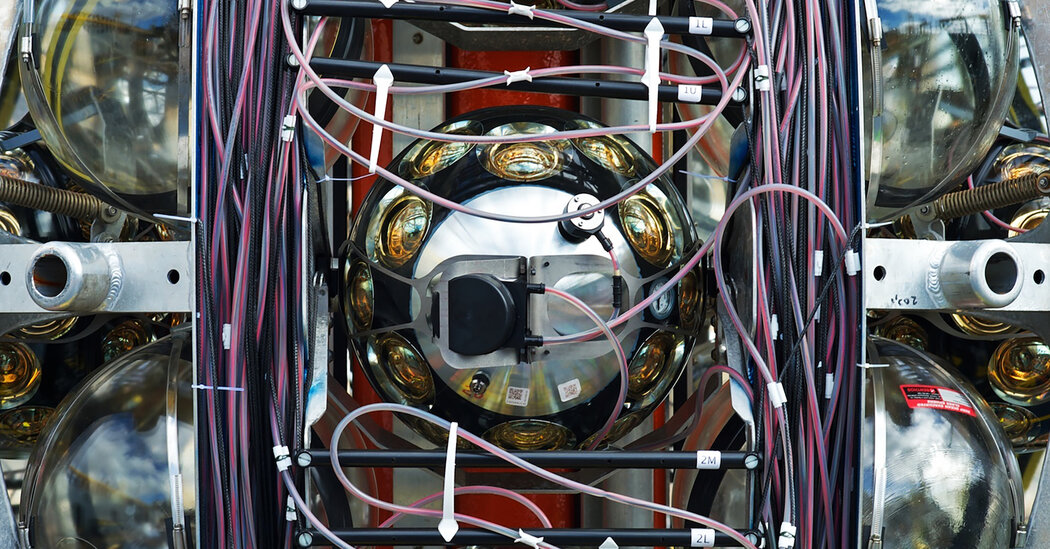Deep in the waters of the Mediterranean Sea, physicists have uncovered evidence of a ghostly subatomic particle catapulting through space at a speed they once could only dream of.
“What we have discovered is, we think, the most energetic neutrino ever recorded on Earth,” said Paul de Jong, a physicist at the University of Amsterdam and current spokesperson for the global collaboration of roughly 350 scientists who were involved in the discovery.
The team announced its “ultrahigh energy” neutrino on Wednesday, in a paper published in the journal Nature. The finding brings physicists and astronomers one step closer to understanding just what, exactly, is out there thrusting particles to such unfathomable speeds.
At a news conference on Tuesday, researchers described the discovery as a peek into what the universe looks like at its most extreme. “We’ve just opened a completely new window,” said Paschal Coyle, an astroparticle physicist at the Center for Particle Physics of Marseille in France. “It’s really a very exciting first glimpse into this energy regime.”
Neutrinos are notoriously antisocial. Unlike most other particles, they are nearly weightless and carry no electrical charge, so they do not regularly collide, repel or otherwise interact with matter. They flow through nearly everything — the innards of stars, the churning dust of galaxies, ordinary people — without a trace.
Thus unimpeded, neutrinos point straight back to their origins, making them excellent guides to the natural, yet-unknown “cosmic accelerators” that created them. They are also spectacularly elusive, and for decades scientists have worked to trap them with instruments deep in the mountains, beneath frozen lakes and buried in Antarctic ice.
But no neutrino captured previously has resembled anything quite like this one. Scientists found the ultrahigh energy neutrino using the Kilometer Cube Neutrino Telescope, or KM3NeT, which is still under construction but already operating. The instrument consists of a pair of detectors a couple of miles beneath the surface of the Mediterranean, off the coasts of France and Sicily.
One detector — made up of strings of light-catching orbs, spaced about the length of a football field apart and anchored to the seabed — was only 10 percent built when one-third of its sensors lit up with the characteristic flash of a neutrino observation.
The detector did not see the neutrino directly. Rather, it picked up traces of a different subatomic particle, known as a muon, created when the neutrino bumped into rock or seawater nearby.
That muon zipped through KM3NeT at lightning-fast speed, leaving a trail of bright blue photons in the otherwise dark abyss of the sea. Using the pattern of light, as well as the time of its arrival at different parts of the grid, the team deduced the direction of the original neutrino. They also estimated that the neutrino carried 220 million billion electronvolts of energy.
That’s no greater than the energy of a falling Ping-Pong ball. But the energy of a Ping-Pong ball is spread over a thousand billion billion particles. Here, squeezed into one of the tiniest flecks of matter in our universe, that energy amounted to tens of thousands of times more than what can be achieved by the world’s premier particle accelerator, the Large Hadron Collider at CERN.
The telescope recorded the ultrahigh energy neutrino in February 2023. But researchers needed two years to interpret and analyze the data, during which time they swung between elation and skepticism.
It “took a while to sink in, to be honest,” Aart Heijboer, a neutrino astronomer at the National Institute for Subatomic Physics in the Netherlands, said at Tuesday’s news conference. Another scientist said that the particle’s energy was so extreme that its total data crashed his computer.
Before the discovery, the highest-energy neutrino ever detected was around 10 million billion electronvolts. That then-impressive record was set in 2014 by the IceCube Neutrino Observatory, an even bigger grid of light sensors embedded in the Antarctic ice.
It is rare for an instrument like KM3NeT to detect such an extraordinary neutrino so early in its lifetime, which added to skepticism of the result. Erik Blaufuss, an IceCube physicist at the University of Maryland who wrote a corresponding comment in Nature on Wednesday, said he first heard hints of the discovery at conferences last summer. “I think there was a lot of disbelief that this could be real,” Dr. Blaufuss said. “In a decade of observations, we haven’t seen anything quite like this.”
KM3NeT got lucky, according to Naoko Kurahashi Neilson, an astrophysicist at Drexel University who is not formally on the telescope’s team but has observer status. “It’s amazing proof that their detector works well,” she said, adding that the detection of one neutrino alone “raises many more questions than it answers.”
One big question is what sort of cosmic accelerator might have generated such energetic particles. Perhaps a supermassive black hole voraciously devouring the gas and dust surrounding it. Or maybe a cataclysmic burst of gamma rays, the highest energy form of light, which occurs when the heart of a star caves in on itself.
Such processes emit charged particles that may smash into nearby matter, generating a flurry of neutrinos that race through the cosmos and, sometimes, into telescopes on Earth. Another theory is that those charged particles interact with the light left over from the Big Bang, creating “cosmogenic” neutrinos that may carry secrets about the evolution of the universe.
The KM3NeT team will work to nail down the direction of the neutrino more precisely, to better pinpoint the particle’s origin. And as the telescope approaches completion in 2028, scientists hope that more neutrinos of comparable pep might reveal themselves.
To Dr. de Jong, the discovery underscored the importance of trying new types of detection, like acoustic and radio sensing, that may be better able to catch neutrinos at ultrahigh energies.
“Now, we know these neutrinos are not just predicted,” he said. “They’re there. They’re real.”

